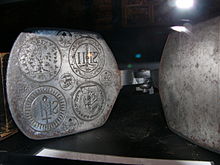Host irons
A wafer iron , also wafer iron ( lat. Ferrum characteratum to Greek χαρακτήρ "stamp, coinage", also "stamp iron, embossing iron", or [ferrum] oblatorium zu oblata "sacrificial offerings", ie "iron for the sacrificial bread, wafer iron") is a device for baking hosts that are used for the administration of the Eucharist . Such host irons, similar to the principle of a waffle iron , consist of two plates that are brought together by lever action. On the lower plate of a host iron, decorative representations for several hosts are engraved, which are transferred to the dough by the pressure and fixed by baking the hosts.
history
Already in early Christian times, altar breads were marked with the sign of the cross, sometimes with a point. The oldest such representations come from the catacombs .
Because of the holiness of the sacrament of the Eucharist, people did not want altar breads to be made by secular bakers. While the altar bread was often prepared at home by Christian women in the early days of the Church, the making was later passed on to the clergy , in the congregations and in the monasteries. As a rule of St. Pachomius (around 325) is recommended to the monks to contemplate while preparing the altar bread. Until the Middle Ages , hosts were only baked in a very solemn rite before three or four major festivals of the church year ; later this habit was abandoned because it was assumed that the substance of the bread would change during such a long storage time. St. Charles Borromeo, for example, ordered that only hosts that were not older than twenty days could be used in his diocese. The Congregation for the Rites condemned the practice of consecrating hosts in the Eucharist that had been baked three or six months earlier.
In the monasteries (indicated on the floor plan of St. Gallen, for example) they had their own rooms for the preparation of the altar bread, ovens and host irons, in which it was pressed in wafer form, usually provided with the symbol of the crucifix . Such irons are listed in the treasury registers of several monasteries.
The earliest evidence of the use of a wafer or wafer iron to make altar bread comes from Carthage in the 6th or 7th century, even before the city was destroyed by the Arabs. On this iron there is the inscription Hic est flos campi et lilium , “This is a flower of the field and a lily” around the Christ monogram based on Hld 2,1 EU . Further evidence of the use of host irons is attested for the 9th century.
Between the 9th and 11th centuries, the Latin Church began to use unleavened wheat bread for consecration in Holy Mass , out of concern that the holy of holies would be dishonored when using the more easily crumbling leavened bread. Gradually, people began to bake thin slices of bread for distribution to the faithful in order to avoid breaking the bread multiple times. These were baked in a metal mold. A decorative embossing was affixed to the somewhat larger celebration hosts for the priest - initially a cross notch as in previous centuries, now preferably richly decorated representations, including inscriptions and inscriptions ( imago domini cum litteris , "image of the Lord with text") . Even Francis of Assisi worried about beautiful host iron in the churches.
The lower plate of such an iron was provided with two, four or six diagrams for hosts. They were used to make hosts of various thicknesses, about the size of a hand. By the end of the 11th century, their size decreased considerably, so that four hosts, two large and two small, could now be made with one host iron. In the late eleventh century, the custom of making large celebratory hosts for the priests and small hosts, the size of a coin, for the communicants was gradually adopted . The host irons, which have been preserved in large numbers from the 16th and 17th centuries, show that the hosts made with them are quite similar to those used today. They are richly decorated with images of the Lamb on the Book with the Seven Seals , the Crucifixion, the Lamb of God or the Christ monogram surrounded by a vine and from which rays emanate. Particularly large hosts were also baked for monstrances .
Web links
Individual evidence
- ^ Henri Leclercq, in The Catholic Encyclopedia . Vol. 7. New York: Robert Appleton Company, 1910. Sept. 10, 2013 < http://www.newadvent.org/cathen/07489d.htm >.
- ^ Henri Leclercq, in The Catholic Encyclopedia . Vol. 7. New York: Robert Appleton Company, 1910. Sept. 10, 2013.
- ^ Heinrich Bergner, Handbook of Church Antiquities of Art in Germany , CH Tauchnitz, Leipzig, 1905.
- ^ Henri Leclercq, in The Catholic Encyclopedia . Vol. 7. New York: Robert Appleton Company, 1910. Sept. 10, 2013.
- ↑ Miraculi s. Wall regisili . n. 53, and with Bishop Ildefons: Revalation (around 845); Josef Andreas Jungmann : Missarum Sollemnia. A genetic explanation of the Roman mass. Second volume, 5th edition. Nova & Vetera, Bonn and Herder, Vienna-Freiburg-Basel 1962, p. 46, note 34; Josef Andreas Jungmann: Host irons . In: Walter Kasper (Ed.): Lexicon for Theology and Church . 3. Edition. tape 5 . Herder, Freiburg im Breisgau 1996 .; FF Niermeyer / C. van de Kieft: Mediae Latinitatis Lexicon Minus. Middle Latin dictionary. Vol. II M − Z, Wissenschaftliche Buchgesellschaft, 2nd edition, Leiden 2002, p. 949 refers to the Miraculi Wandregisili and translates oblatorium as “waffle iron” ( gaufrier , wafer-iron ).
- ^ Franz Nikolasch: bread. II. Liturgical . In: Walter Kasper (Ed.): Lexicon for Theology and Church . 3. Edition. tape 2 . Herder, Freiburg im Breisgau 1994.
- ^ Josef Andreas Jungmann: Missarum Sollemnia. A genetic explanation of the Roman mass. Second volume, 5th edition. Nova & Vetera, Bonn and Herder, Vienna-Freiburg-Basel 1962, p. 46f.
